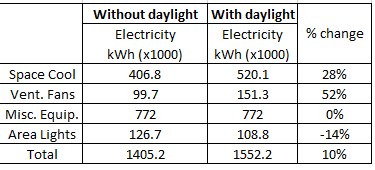This is a very peculiar behaviour in this model.
After looking at the .inp, I couldn't see anything immediately that was the cause.
I noticed that the model with daylighting had significantly higher autosized system cooling capacities than the model with no daylighting. This was on all floors, not just the floor with daylighting. You may want to try specifying the cooling capacity of each system in the daylighting model, with the autosized capacities from the non-daylighting model.
It could also be related to the windows - many of the windows on the third floor are specified using the "Simplified" specification method. I don't fully understand why, but I've been told that eQuest doesn't properly handle the angle of incidence of solar radiation to the window when they are "Simplified", and so it may not be giving you the correct solar gains in those third floor spaces. What this means is that when you turn on the daylighting calculation, it may be giving you too much solar gains in those spaces when it does the daylight calculation, resulting in higher cooling loads. You might try a window from the glass library and see if that makes a difference.
One other comment, Ashok, that isn't related to this problem, but I wanted to let you know - when you use the VRF curves provided by Daikin and import them into the eQuest, one of the heating curves doesn't import properly - the line is too long and eQuest truncates the exponent.
The curve "VRV Heating EIR-F-EWB/ODB AC" imports with coefficient number 4 as 7.145853, but it should be 0.07145853 in the model. Again, not a problem for you since you aren't using that particular curve, but could be a problem down the line. :)







Which weather file are you using?
Jaipur, India (composite climate)
Did you figure this out? I'd be interested to hear the outcome.
@adam: thank you for interest, i will share for sure if i get any solution.